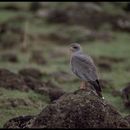Biology
(
Inglês
)
fornecido por Arkive
The dark chanting-goshawk feeds mainly on rodents, birds and reptiles but will also take frogs and insects, and is not averse to carrion. It typically hunts from the perch, spending long periods attentively scanning its surroundings before swooping down to catch prey off the ground. Occasionally it will embark on high-speed aerial pursuits in order to take birds in flight. In addition, this goshawk has been observed following foraging ground-hornbills and honeybadgers to poach the prey they flush out (2) (6).
Although sedentary in most parts of its range, some West African populations are known to be partially nomadic during the dry season (2) (4). During breeding, the timing of which varies from region to region, the dark chanting-goshawk becomes very vocal, with pairs chanting melodiously from the tree tops before nesting (2) (7). One to two eggs are incubated for around 30 days in a stick nest built in a low fork in dense woodland (2) (6). The juveniles fledge from between 36 and 50 days, but are very noisy in the nest area for up to another five months (2).
Conservation
(
Inglês
)
fornecido por Arkive
There are no known conservation measures in place for the dark chanting-goshawk but it almost certainly occurs in numerous protected areas across its range (9).
Description
(
Inglês
)
fornecido por Arkive
The dark chanting goshawk is a bulky hawk, often seen in full view, perched upright on long, orange-red legs (4) (5). The head, chest and upperparts are essentially dark grey, while the abdomen, thighs and rump are all finely barred with black over white (4). The wing primaries are black, and the tail is broadly barred black and white (2) (4). Like the legs, the bare patch of skin at the base of the bill, called the cere, is orange-red. The female is, on average, larger than the male, but both sexes are very similar in appearance, while juveniles tend to have browner plumage (4). Five subspecies are recognised that occupy different parts of the species' overall range and exhibit slight differences in size and appearance (2) (4).
Habitat
(
Inglês
)
fornecido por Arkive
The dark chanting-goshawk is typically found in open broadleaved woodland and wooded savannah (2) (4).
Range
(
Inglês
)
fornecido por Arkive
The distribution of the dark chanting-goshawk includes much of sub-Saharan Africa from Senegal across to Sudan and western Ethiopia, and south as far as northeast South Africa, excluding arid and forested regions. In addition this species is known from the southwest Arabian Peninsula and southwest Morocco (2) (4) (6).
Status
(
Inglês
)
fornecido por Arkive
Classified as Least Concern (LC) on the IUCN Red List (1) and listed on Appendix II of CITES (3).
Threats
(
Inglês
)
fornecido por Arkive
Throughout most of its range, the dark-chanting goshawk is widespread and common and therefore not globally threatened (2) (8). However, some of the isolated populations, such as those occurring in Morocco and the Arabian Peninsula, are extremely vulnerable to clearance of woodland (2). In particular the subspecies Melierax metabates theresae, confined to Morocco, is thought to be on the point of extinction due to deforestation and human predation (6)

